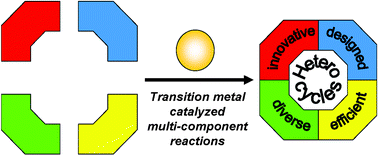For a long time multi-component syntheses of heterocycles have undeniably been a domain of classical carbonyl condensation chemistry. However, the advent of transition-metal catalysis not only has fertilized strategies in heterocyclic synthesis by uni- and bimolecular transformations but the past decade has also witnessed a rapid development of transition-metal catalysis in new multi-component reactions (MCR). Expectedly, palladium catalyzed processes have received a dominant position, yet, other transition-metal complexes are catching up implying organometallic elementary steps that reach even further than cross-coupling and carbometallation. Besides domino MCRs that are purely based upon organometallic catalysis the sequential and consecutive combination with condensation, addition and cycloaddition steps opens a vast playground for the invention of new sequences in heterocyclic synthesis. This tutorial review outlines the underlying reaction based principles of transition-metal catalysis in multi-component syntheses of heterocycles, summarizes recent developments of palladium catalyzed MCR, and highlights the more recent contributions to MCR based heterocyclic synthesis by virtue of rhodium, ruthenium, and copper catalysis.

You have access to this article
 Please wait while we load your content...
Something went wrong. Try again?
Please wait while we load your content...
Something went wrong. Try again?


 Please wait while we load your content...
Please wait while we load your content...